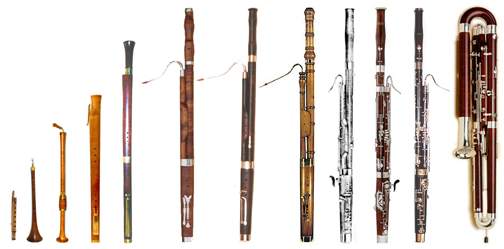
Dulcian is one of many names used to describe the one-piece ancestor of the modern bassoon. "Dulcian" derives from the Latin dulc, meaning soft or sweet, since the instrument has a more subdued quality than its close cousin - the shawm. Then, we'll explore medieval sounds of Croatia in our featured release Dalmatica: Chants of the Adriatic.Â
We heard a Castello sonata, from Caecilia-Concert's release Castello & Co: Venetian Sonatas for winds and strings from the 17th century, from Challenge Classics.
Sounds of the Dulcian
Today, we're exploring the sweet and rich sounds of the dulcian. A double reed instrument made from a single piece of wood, the dulcian was used primarily in the late Renaissance and early Baroque periods; however, it remained in use in Spain and the New World until much later.
Giovanni Antonio Bertoli's "Compositioni Musicali" from 1645 is likely the first published dulcian sonata collection. This collection is notable as well for being the first solo collection dedicated to any single instrument. Like many composers of his day, Bertoli was a virtuosic performer on the instrument he was writing for. He was well aware of the technical demands made on the dulcian performer, and sought to expand and showcase these abilities in his own pieces.
Bertoli performed by harpsichordist Kathryn Cok and dulcian player Wouter Verschuren.
Bertoli's Sonata number VII for dulcian or bassoon, performed by Wouter Verschuren from Challenge Classics 2012 release Castello & Co.
The dulcian was a popular chamber instrument as well, where it was utilized with various instruments including violin, cornetto, sackbut, and shawm. Keeping with the dolce character of the dulcian, we'll hear a Sonata á 4 by Matthias Weckmann and an anonymous Ciaconna.
We heard a seventeenth century Ciaconna; that was preceded by a Sonata á 4 by Matthias Weckmann. Ensemble Quicksilver, on the 2012 Acis release Fantasticus: Extravagant and Virtuosic Music of the German Seventeenth Century.
All In the Family
Instrument families were all the rage in the Renaissance. It wouldn't be unusual to hear someone say to a friend, "Come over for supper and then we'll open the chest of viols!" The dulcian family includes sizes soprano through contrabass. On the smallest dulcian, the bell blasts in the player's face, rising just above the nose. The largest dulcian, in contrast, is over six feet tall! We'll start with a small family, two dulcians performing Canzona a 2 by Bartolome Selma y Salaverde. Then the family grows as we listen to a dance called a "brall," spelled b-r-a-n-s-le, from Susato's collection Danserye. Music performed by Syntagma Amici for dulcian family.
A dance piece from Susato's "Danserye." Before that we heard  a Canzona by Bartolome Selma y Salaverde, performed by Syntagma Amici.
The Nanny Goat Bassoonist
The historical transition from the dulcian to the bassoon wasn't always easy. Bach himself once had a spat with a bassoon student in Arnstad, calling him a "nanny goat bassoonist." The feud was not one-sided… The student called Bach a "dirty dog," and the two reportedly fell into a skirmish, which ultimately resulted in Bach drawing his sword.
Still, Johann Sebastian Bach did feature the bassoon a few times in his vast canon. The "Quoniam" from the B Minor Mass is well known both to horn players and bassoonists, whose duet forms a pillow for the horn solo in this bass aria.
Franz-Josef Selig, bass, sang "Quoniam tu solus Sanctus" from Bach's B Minor Mass. Berlin Akademie für Alte Musik conducted by René Jacobs.
In other quarters, the bassoon proved quite popular - Vivaldi wrote more concertos for the bassoon than any instrument other than the violin.
Vivaldi's bassoon concerto in D, RV 481 performed by the Seattle Baroque Orchestra with Michael McCraw, bassoon soloist.
Dalmatica: Chants of the Adriatic
Our featured recording this week is Dalmatica: Chants of the Adriatic. On this recording, vocal ensemble Dialogos, directed by Katarina Livljanic, is joined by six cantors from Croatia to explore sacred works from the Adriatic coast. In addition to Latin, Croatian sacred music utilized Old Slavic and Old Croatian languages. The title of the recording, "Dalmatica," is a medieval garment worn both by men and women. The dalmatica is associated with Byzantine clergy and can be seen as a link between Byzantine and Roman Catholic traditions. The dalmatica inspired collaboration on this recording between an all-female vocal group, Dialogos and an all-male group, Kantaduri.
Here is "Govorenje Judino," which depicts Judas' haunting monologue before hanging himself.
"Govorenje Judino" from the recording Dalmatica – Chants of the Adriatic. Dialogos Singer and director Katarina Livljanic was featured there with the ensemble Kantaduri.
We'll close with a traditional Christmas chant from Croatia, which translates as "Oh God is born," sung by Kantaduri, and "Crucem tuam adoramus," which is an Antiphon for the Adoration of the Cross used on Good Friday, performed by Dialogos and Kantaduri.
"Crucem tuam adoramus" and "God is born," from the 2016 Arcana label release Dalmatica – Chants of the Adriatic.Â
Break and theme music
:30, Fagotto, Basson, Dulcian, Curtal?, Syntagma Amici / Jeremie Papasergio, bassoons and director, Ricercar 2009, Tr. 1 Praetorius Terpsicore
:60, Fantasticus: Extravagant and Virtuosic Music of the German Seventeenth Century, Quicksilver / Robert Mealy and Julie Andrijeski, violins and directors; Dominic Teresi, dulcian, Acis 2014, Tr. 1 Matthias Weckmann: Sonata á 4, No. 9Â
:30, Dalmatica: Chants of the Adriatic, Dialogos, Kantaduri, Arcana 2016, Tr. 5 Spavaj, spavaj, diti?u, ti nebeski Kralji?uÂ
Theme:Â Danse Royale, Ensemble Alcatraz, Elektra Nonesuch 79240-2 1992 B000005J0B, Tr. 12 La Prime Estampie Royal
The writers for this edition of Harmonia was Sarah Huebsch.
Learn more about recent early music CDs on the Harmonia Early Music Podcast. You can subscribe on iTunes or at http://www.harmoniaearlymusic.org.









